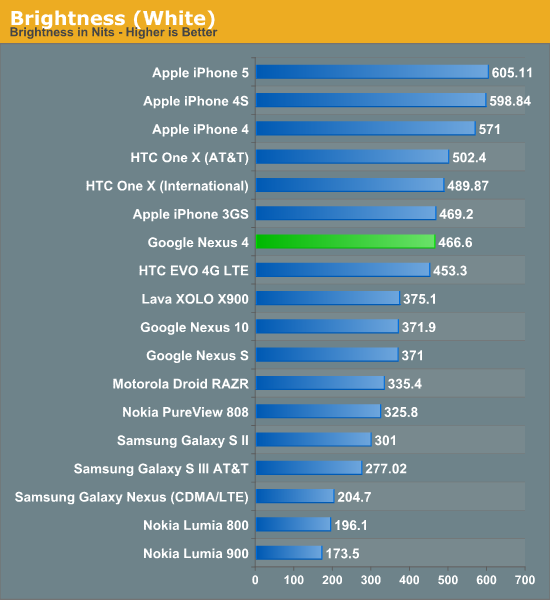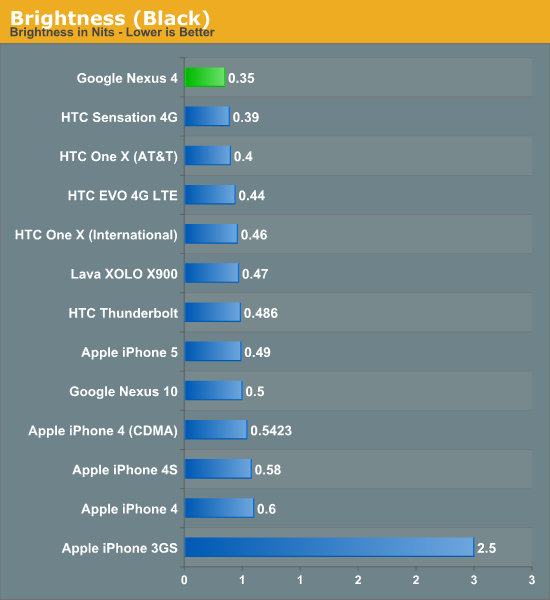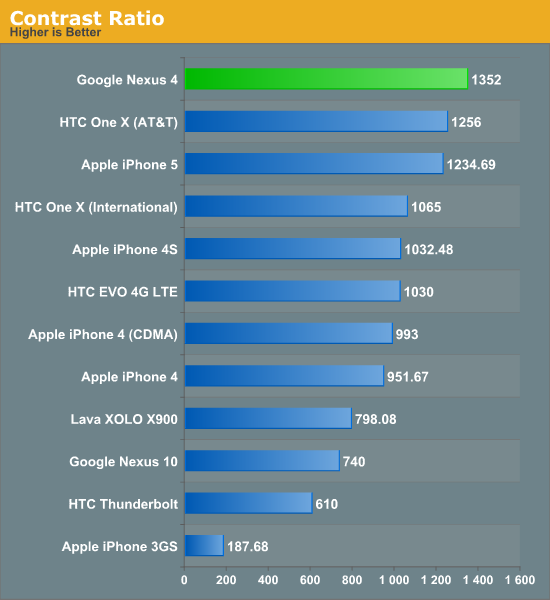Google Nexus 4 Review - Google's new Flagship
by Brian Klug on November 13, 2012 8:45 AM EST- Posted in
- Smartphones
- LG
- Android
- Mobile
- APQ8064
- Nexus 4
- Android 4.2
- MDM9215
The display on the Nexus 4 is another shared component between the Optimus G, and is a 4.7-inch IPS WXGA (1280x768) LCD, which is of course home to an RGB stripe and in-cell touch, or as LG calls it, "zerogap" touch. LG Display unsurprisingly knows how to make LCD displays, and the Nexus 4 display looks subjectively very good. At 320 PPI I can’t see any pixels, and don’t think we need to get into the whole visual acuity discussion again, it’s very good on the Nexus 4. The added width over straight 720p is something I noted was actually very refreshing on the Optimus G when playing with that device in Korea. Most apps scale appropriately and take advantage of it without any issue, and the extra width definitely is noticeable in Chrome, Plume, and all my daily drivers.



The Nexus 4 display goes very bright, at 466 nits, and achieves a contrast ratio of 1352:1 at that maximum brightness setting. This is a huge step over the barely 200 nits that the Galaxy Nexus could eek out.
| CalMAN Display Comparison | |||||||||
| Metric | iPhone 5 | iPhone 4S | HTC One X | Samsung Galaxy S 3 | Samsung Galaxy Note 2 | Google Nexus 4 | |||
| Grayscale 200nits Avg dE2000 | 3.564 | 6.162 | 6.609 | 4.578 | 5.867 | 7.686 | |||
| CCT Avg (K) | 6925 | 7171 | 5944 | 6809 | 7109 | 8506 | |||
| Saturation Sweep Avg dE2000 | 3.591 | 8.787 | 5.066 | 5.460 | 7.986 | 8.517 | |||
| GMB ColorChecker Avg dE2000 | 4.747 | 6.328 | 6.963 | 7.322 | 8.185 | 7.531 | |||
I’ve mentioned that Google continues to struggle at calibrating their displays. The truth is that everyone except for Apple, HTC, and occasionally Samsung, struggle at calibrating mobile displays. This continues to be the case with the Nexus 4, and the result is that accuracy could be better. I’m convinced the results that we’re getting out of the Nexus 4 basically represent no attempt at calibrating the display, and as a result the numbers suffer.
















188 Comments
View All Comments
amdwilliam1985 - Tuesday, November 13, 2012 - link
These smart phones and tablets are the old computing devices that you used to love in a new form and shape.I can't remember the last time I got excited about "computer" hardware.
phillyry - Thursday, November 15, 2012 - link
+1A5 - Tuesday, November 13, 2012 - link
Intel, AMD, and Nvidia only really do 1 hardware launch a year now, the motherboards are all essentially the same, and driver reviews are borrrrrring to perform and read.They're still putting up like 3-4 case reviews a month, but there really isn't much else to talk about besides mobile stuff anymore.
Sabresiberian - Tuesday, November 13, 2012 - link
I don't read every article Anandtech publishes; in fact, if there is an article I just skim through, or skip entirely, it will be one about any kind of mobile computing, including smart phones. It doesn't bother me though that Anandtech spends as much time on these things as they do because they still do plenty of high quality articles on mainboards, CPUs, graphics cards, PSUs - the things I am interested in, and they have added editors to cover additional types of hardware, and, bottom line, I don't expect everything they publish to have me in mind.;)
Impulses - Tuesday, November 13, 2012 - link
They still do more in depth CPU and architecture articles than most sites, probably due in large part to Anand's knowledge and contacts. They've been doing a ton of case reviews too... Motherboards have been boring for quite a while. I don't think any of that content has suffered much. The one thing I'd say has suffered is GPU reviews, Anand does a great job of analyzing new architectures at times but their benchmark methods (and variety of tested resolutions) pale in comparison to other sites IMO.Impulses - Tuesday, November 13, 2012 - link
Not that I'm complaining mind you, there's other places to read about that stuff... However none of the quasi-blogs that cover the mobile industry do phone reviews as detailed and in depth as AT. Something as simple as standardized battery testing seems to elude the entire web outside of AT, at best you might find rundown tests with a movie or something lazy like that.tipoo - Tuesday, November 13, 2012 - link
It's just about speed of updates. There's a new top end smartphone every other day, while CPU architectures don't make big changes for up to two years and GPUs at least a year.phillyry - Thursday, November 15, 2012 - link
Home-made desktop PCs are verging on irrelevant.Mobile is where it's heading.
Don't get me wrong, it still exists but it's just becoming less and less relevant.
darklight0tr - Tuesday, November 13, 2012 - link
I have a Galaxy Nexus and was looking to possibly upgrade to the Nexus 4 but there are a few big issues with the phone for me:1. No LTE and it isn't available on Verizon (at least right now).
2. Max of 16GB flash memory. I have the LTE Nexus and enjoy the 32GB of flash memory.
3. Headphone jack and charging port are on OPPOSITE sides of the phone. This is the biggest fail for me. I use my Galaxy Nexus in my car nearly every day and having those two connectors on the same side is very important.
Its too bad because it looks to be a great phone otherwise.
Despoiler - Wednesday, November 14, 2012 - link
The Nexus 4 will never come to Verizon. Not including LTE was primarily a political move, secondary a battery life consideration, and tertiary for SKU simplicity.Verizon had their hands all over the Android releases on the Samsung Nexus causing them to be delayed or scrapped for the next release. It's a dev phone though. Google needs to be able to roll out whatever it wants to when it wants to. Breaking carrier control on handsets is part of what Google has been trying to do with their Nexus phones.
32GB of memory is unnecessary with Google services like Music and Drive. Everything is on the cloud so why does it also need to be on your phone?